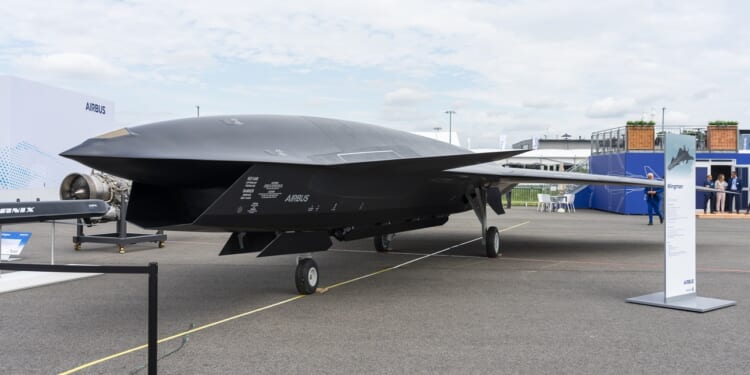The world is entering a new era of air warfare—one in which the locus of power lies in who controls the “mind” of the aircraft, not just the wings.
The Netherlands has agreed to join the United States Air Force’s “Loyal Wingman” program, otherwise known as the Collaborative Combat Aircraft (CCA) program. The two countries will pool resources toward creating manned-unmanned teaming (MUMT), allowing for greater interoperability between the United States military and the militaries of its NATO allies on the issue of drone technology.
It makes sense for the Netherlands to enter into the CCA program. Amsterdam already cooperates with the United States on the F-35 Lightning II fifth-generation warplane program, and collaborating on CCAs would make it easier for it to reliably integrate CCAs into the F-35 fleet once they are complete. The Dutch view this as a moment in which to deepen their ties with the United States—all while enhancing European defense cooperation and creating greater levels of burden-sharing within the transatlantic alliance on a key issue.
The US-Netherlands Deal on CCA Development
Defense One, a popular trade publication, points out that the move by the Netherlands is a response to rising security pressures—notably from Russia, which has seen increased drone threats appear over Europe. While relatively isolated from Russia geographically, the Dutch fear the employment of hybrid warfare techniques by the Russians. As such, the Netherlands military wants to be prepared to rebuff any probing of their airspace by Russian drones—or other probing tactics Moscow may employ to create chaos and increase risk to the Netherlands.
At a time when the Americans are looking to reduce their standing in Europe and have locals take up their own defense more fully, the Netherlands may have found a way to keep the Americans invested in at least their defense—by partnering with Washington to develop these CCA capabilities. In essence, the Netherlands is enmeshing itself within a key American defense program—and in so doing putting itself ahead of Germany, Italy, Spain, and Poland.
A Win for the Netherlands Could Be a Loss for America
On the one hand, this is a step toward shared European defense capability. On the other, it underscores Europe’s abject dependency on the United States for technological leadership. A recent South China Morning Post essay argues that Europe is losing the tech race to both China and the United States. Meanwhile, Foreign Affairs illustrates how utterly reliant on foreign sources of technology that Europe is, meaning they are rapidly losing the chips race.
The Netherlands proves the SCMP and Foreign Affairs pieces true by joining the United States in this MUMT development project. The real challenge will be whether Europe can carve out sovereignty in AI, autonomy, and drone warfare—or remain a lesser partner within the US-dominated framework.
It is important to remember that the United States doesn’t only sell weapons. It also sells the technological ecosystems supporting those weapons—software, command-and-control sustainment, data links, artificial intelligence algorithms, and so on. In so doing, Washington locks in collaborative dependencies. This ensures interoperability, as noted above, but it also forces the Americans to be more engaged on the continent—at a time when many of President Donald Trump’s supporters were of the mind that he was going to be stepping back.
The old paradigm of manned jets in aerial duels is giving way to these hybrid drone and manned plane teams, sensor networks, and AI-managed battlespace. In this new paradigm, who controls the software, who writes the algorithms, and who defines the link architecture are far more important questions than raw airframe performance.
There are some issues, of course, that arise beyond continued European dependence. As Europe fields more autonomous combat systems, adversaries may feel compelled to overmatch or counter with electronic warfare, AI hacking, or swarms. The technology race could spiral. Further, there is little indication that NATO is seriously prepared for the kind of onslaught that might occur if things with Russia ever tipped into full-blown warfare. There are already indicators that things are going to go awry the longer the Ukraine War continues, and the Trump administration is unable to get a peace deal.
Europe’s Future is Spoken For
What we see in this move by the Netherlands is the acceleration of a new era of combined unmanned and manned air combat craft—one in which the locus of power lies in who controls the “mind” of the system, not just the wings. The Dutch are betting hard that the future of European security lies in alliance integration and technological alignment. But the real question in the long run is whether Europe can become a co-master of its destiny, or simply continue as a client of America’s high-tech war machine.
What few in Europe appear to be considering is what will likely happen: that the Europeans will continue expecting American support, while Washington continues backing away from the continent and the Russians (and to some extent the Chinese) keep moving in. Without an indigenous capacity to build and compete using its own systems, Europe will simply be subsumed either by the United States, Russia and/or China. No amount of MUMT investment with the Americans will change this.
About the Author: Brandon J. Weichert
Brandon J. Weichert is a senior national security editor at The National Interest. Recently, Weichert became the host of The National Security Hour on America Outloud News and iHeartRadio, where he discusses national security policy every Wednesday at 8pm Eastern. He is also a contributor at Popular Mechanics and has consulted regularly with various government institutions and private organizations on geopolitical issues. Weichert’s writings have appeared in multiple publications, including The Washington Times, National Review, The American Spectator, MSN, The Asia Times, and others. His books include Winning Space: How America Remains a Superpower, Biohacked: China’s Race to Control Life, and The Shadow War: Iran’s Quest for Supremacy. His newest book, A Disaster of Our Own Making: How the West Lost Ukraine is available for purchase wherever books are sold. He can be followed via Twitter @WeTheBrandon.
Image: Shutterstock / Sergey Kohl.

















